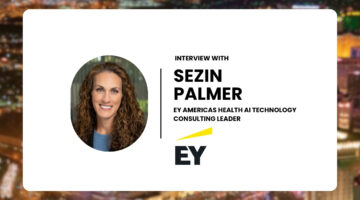This past fall, the Centers for Medicare and Medicaid Services (CMS) issued its final rules on Chronic Care Remote Physiologic Monitoring (RPM). Following on from the inclusion of three new current procedural terminology (CPT) codes in the 2019 Physician Fee Schedule, CMS has added a code for remote patient monitoring in 2020 that allows the billing of an additional 20 minutes of clinical time. It also removed a number of provisions that had made RPM operationally challenging.
This is a big deal in the RPM industry. Firstly, it demonstrates CMS’ continued endorsement and belief in RPM and its potential to improve patient outcomes and reduce cost. Secondly, the new rules are expected to drive improved return on investment for providers. As a result, providers will be more likely to invest in RPM technology and harness both the operational and care benefits it presents to hospitals and patients, respectively.

Where AI Has The Most Potential For Clear ROI
Sezin Palmer talks about where AI has the most potential for ROI.
Still, questions remain for providers. What are the major ways in which RPM impacts care delivery and hospital operations? What should be considered when evaluating solutions and deploying RPM technology? Here, we address these questions to arm providers with the insights they need to obtain maximum value from RPM investments.
How RPM Impacts Hospital Operations and Care Delivery
While RPM services can be managed by auxiliary personnel, a key issue that providers and RPM vendors had with CMS’ 2019 final rule was that those individuals must be under direct supervision of the physician. This means that the physician must be in the same building as the personnel delivering and managing the RPM service.
This has been changed with the CMS rule going into effect in 2020. Now, those personnel need only be under general supervision; the physician does not need to be in the same building. This allows for scalable, flexible RPM programs to be created that allow proactive management of patients at home. The additional 20 minutes of time also significantly increases the potential revenue for providers, making it financially viable.
By using RPM to manage patients outside of the hospital, providers can more appropriately allocate resources. With RPM-powered insights, doctors and nurses can identify earlier which patients require intervention, and which can continue to be managed remotely with less frequent or time-sensitive visits and check-ins. Not only does this help optimize doctors’ and nurses’ time, but it also reserves limited hospital beds for those who most need them. Moreover, it has the potential to allow patients to leave the hospital earlier and further free up hospital capacity.

Fixing Primary Care: How AI Is Solving the EHR Problem & Admin Overload
Kyna Fong joins us and shares how AI in being deployed in their platform.
Beyond streamlining hospital operations, the potential for better care via RPM can also be better fulfilled under the new CMS rules. By helping manage patients remotely and mitigating unnecessary hospital visits, RPM can reduce the risk of patients contracting hospital-acquired infections and allow them to recover more quickly in the comfort of their own home. Not only that, but patients can receive better care from their providers when doctors and nurses have a more comprehensive view of their overall health based on data from RPM solutions, as well as historic records. With more patient information afforded by RPM, providers can design optimal treatment plans that account for patients’ medical past and present – and position them for a better medical future.
What Providers Should Consider When Evaluating RPM Solutions
While the opportunities presented by RPM are significant, it’s important to remember that not all RPM solutions are created equal. To derive optimal value from RPM solutions, providers should ask themselves – and prospective vendors – the following questions:
- What health insight can I get from this solution? To secure a holistic understanding of a patient’s health and to determine an appropriate action plan, providers need RPM solutions that passively monitor a patient’s health throughout the day and night. They can use this data to determine how patients’ health evolves over time and how that might impact treatment needs. What is the impact of medications? What happens when they go for a walk? Do they even go for a walk? What happens when they sleep?
- Is the RPM solution more focused on patient monitoring or patient management? While data is important, providers don’t have time to review thousands of data points. Providers should opt for RPM platforms that are focused on analyzing the data to suggest insights and actions.
- How comprehensive is this offering? Providers should ask RPM vendors questions not only about what kind of patient insights they can collect but also how they operationalize the RPM program. How is the kit delivered to the patients? Does the vendor offer clinical support? Does it integrate with the electronic medical record (EMR)? How should staff review the data?
How Providers Can Set Themselves Up for a Successful RPM Deployment
Once providers have selected their RPM solution, they should think critically about how to best roll it out. Some healthcare staff may be unnerved about having to learn yet another new platform (hence the importance of EMR integration) or what might happen if they make a mistake interpreting – or miss – critical patient information via the RPM solution. To get ahead of these potential issues, thorough training is critical – as as is consideration of the clinical pathway. Providers must think through how and in what way they will act on clinical insights yielded from RPM.
Securing healthcare staff buy-in through proper, strategic communication and training is critical for realizing the benefits of RPM. When introducing the technology, providers should consider and communicate how RPM can save doctors and nurses time while imparting the important patient information they need to determine and deliver the right care. By communicating how the technology can make their jobs easier, providers can drive solution utilization and ROI.
And when it comes to measuring ROI, providers should consider KPIs such as the duration of hospital stays, rates of readmissions and patient satisfaction scores to ensure the technology is fulfilling their objectives of better care and improved operations.
Patient buy-in is also critical. Clear communication from the provider to the patient about how RPM can help them feel safer and more secure in their own home is a key part of success. Furthermore, providers should explain, and demonstrate, how RPM affords the opportunity to engage patients in a more constructive, consultative and educational conversation based on real data.
Unleashing the Power of RPM
The potential clinical and economic benefits of RPM are significant. With the new CMS rules going into effect in 2020, providers have more opportunity than ever before to seize these benefits by collecting critical patient information while streamlining talent and spatial resources. By taking a strategic approach to RPM investment and deployment, providers can optimize the ROI of their RPM investments and ensure their staff and patients experience greater satisfaction with the delivery of care. The new CMS rules coming in 2020 are only the start of a decade of healthcare innovation.
Photo: Andreus, Getty Images
Christopher McCann started Current Health in 2015 as a medical student, ultimately leaving at the end of his third year with the belief that technology could have a more profound impact on how care is delivered at scale. Since then, Chris has led the company through many major milestones, including the platform’s FDA clearance in 2019, 3,000% revenue growth in 2020, and growing the team to 150 employees across the U.S. and U.K. in 2021.
Under his leadership, the company raised over $70M in capital before being acquired by Best Buy Health in October 2021. Today, Chris sits on the Best Buy Health leadership team helping to develop its virtual care strategy while also leading operations for the Current Health business.
This post appears through the MedCity Influencers program. Anyone can publish their perspective on business and innovation in healthcare on MedCity News through MedCity Influencers. Click here to find out how.







